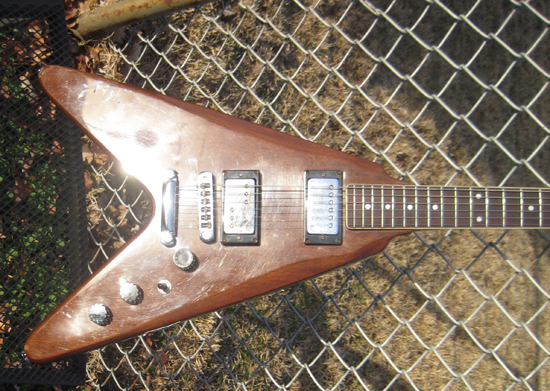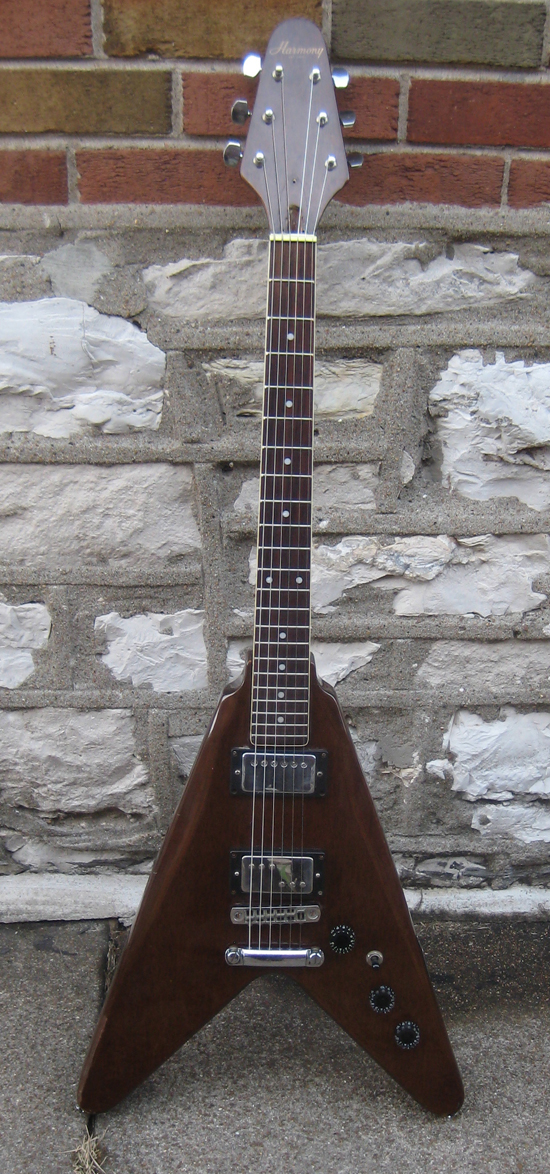
I have a friend with a cool little music store here in St. Louis. I pop in from time to time since he always has a great selection of vintage lap steels, as well as an ever-changing assortment of oddball pieces to check out. As I was on my way out the door after one of my most recent visits, I spotted an early 80s Harmony “Flying V,” and immediately stopped in my tracks. The guitar had no price tag, and as I picked it up for a closer look, my friend told me to make him an offer. I was pretty interested in the guitar, so I quickly went through the complete assessment checklist I use when I’m considering buying a used piece. Following are the things I look for to determine whether a used guitar can be made playable, or if it’s destined to spend the rest of its days as wall art.
Usually, if you’re interested in a piece, the seller is nearby, carefully watching as you look it over…game on. The first thing you need to do is calm down. I have purchased more than one instrument that turned out to be a big old can of worms simply because of my initial eagerness to take it home. I have since learned to put that excitement on hold until I can really check it out, and know exactly what I’m dealing with.
Starting from the top and working my way down, I give the guitar a general inspection. I’m looking for cracks, dings, dents, signs of impact (has the guitar been dropped?), or any broken pieces. I will look especially closely at the headstock area for signs of a repaired break.

Vintage 1980's Harmony Flying V Electric Guitar
I’ll then turn my attention to the tuning gears. The “V” I was looking at had one tuning gear that looked crooked at first glance. Upon further investigation, I found that the gear was not an exact match, and that one of the mounting screws was missing. These were cheap, dust covered, geared tuners, so I figured they would most likely be replaced anyway…not a deal breaker.
I also noticed that all of the pickup ring screws were rusted. Rusted screws can equal more shop time trying to get things apart, so be sure to consider the possibility of having to extract broken or stripped screws.

Vintage 1980's Harmony Flying V Electric Guitar
Once I determined that, aside from some rusty screws and a mismatched tuner, the “V” was in good shape, I started step two of the inspection…the nut. I have found that on guitars like this, the nut can be anything from rough to absurd. With this particular instrument, the latter was the case. This nut was an ugly yellow material, with huge string slots that were filed way too deep, and someone had cut up business cards to use as shim stock underneath. With most used guitar purchases, I’ll typically fabricate a new bone nut anyway, so this wasn’t a deterrent for me, and it even made a nice bargaining tool.
Next on the checklist come the neck and the frets. This is usually the make-or-break point for me when deciding whether or not to buy. I will start by sighting the neck, on both the bass and treble sides, for bow and possible twist in the neck. Too much bow or back bow may be correctable with a truss rod adjustment, or even a heat pressing if necessary, but twisted necks can be more complicated. When I sight the neck, I look straight down the edge where the frets end. I look at it as a continuous plane, all the way to the bridge. I can see back bow, forward bow, and I can spot unlevel frets. The “V” in question had a surprisingly straight neck, with fairly level frets…score!

Vintage 1980's Harmony Flying V Electric Guitar
After determining that the neck itself is in good working order, I’ll look carefully at the neck joint, where the neck meets the body. If the guitar has a set neck, I check the area for cracks or previous repairs. The “V” had a bolt-on neck, which I prefer so that I can shim the neck if necessary to get a proper neck angle. I’ll usually push back and forth a little on the neck to make sure there is no movement. Neck movement can mean loose mounting screws, which will cause tuning problems. Side note: if you haven’t checked your neck mounting screws in a while, you should. Necks can work loose over time and cause problems.
At this point, I take a good look at the body, bridge, controls, and general set-up of the instrument. I’m looking for more rusted screws and parts that may cause problems later, when I do a set-up. For example, bridge saddles can seize up over time, no longer allowing for height or intonation adjustments. While checking the set-up, be sure to check the height of the bridge and individual saddles to determine if the guitar has simply been set up poorly, or if a bigger problem, such as a bad neck set, is present.
My final step in evaluating a used guitar includes plugging it in and playing every note on every fret, to see if I get any buzzing or rattling caused by unlevel frets. I want each note to be clear and in tune. I also check the pots and switches for noise or malfunction. I don’t usually get too bent out of shape with bad electronics, because I will usually upgrade the switch, pots, and sometimes the pickups to a better quality part. This is an area where I usually find that the cheapest products have been used, and a little investment in better electronics can go a long way.
Once I’ve decided what needs to be fixed or replaced, I can begin the bargaining process. My checklist for the “V” revealed a bad tuner, rusty screws, some wonky electronics, and a nut that needed to be replaced. With a bit of haggling, the guitar was mine at a killer price.
I quickly made a new nut, replaced the pots, switch, and jack, and found a Fralin P-92 humbucker to put in the bridge position. After just a few hours of work, I had a killer new “Flying V.” I even had it up and running in time for my wife to play at a show the next night. Looks like I may have to find another one of my own sometime soon.
Happy hunting!
– Dave Anderson

If that flying v just happens to be from Portland oregon originally then it might be the one that I put together on my own it looks exactly like the one I had when I first baught it , it was just the body and the neck. Of u are interested in selling it email me
Ihaveoneoftheasforsale
I have one. White. Gold hardware. Locking tremolo. All original. Still has factory labels and original finish. For sale. For the right price. 530 306-2304
I own two of these V’s. They were from Montgomery Wards in 1983. I received mine Christmas of 1983. It sold for 179.00.
I traded my original for an old Pearl drum set. Fast forward to whenever eBay started getting big. I found a Van exactly like my old V.
I have a friend with a pawn shops and my oldest son spotted a Van like the one I purchased from eBay. He noticed it had my signature on it. I had forgotten that I put a Les Paul pick guard on it.
She had been badly abused. She has since retired and is at home with my other guitars.
That should be V. Not Van, my phone loves correcting me.
I just got one of these beauties a d she roars all original. Guy who sold it to me was some hippie who had it as wall art since it was made. Came w a sweet leather strap. This thing can keep up w any Gibson I’m faced with. Anyone know any info on the original pickups
My 2nd guitar and first electric guitar at 13 yrs old, 1983. Mine came from a JC Penney catalog. We picked it up at the store, It came in a box, fully assembled.
Some neighborhood prick stole it!!!
Im now looking for another one.
I got one as a package deal with another guitar. White with gold hardware. Has the wilkinson styled bridge with brass block. I changed out the tuners for gold grovers w/pearloid turners. Capped the buckers with solid gold covers and put white frames on. Finished up with putting on gold machined speed knobs and a set of zappa 24 karat gold strings. The ol girl is hot and those slotless covers calmed the buckers down just right to give it a great warm blues clean and cutting solos. I own a bunch of flying Vs …some gibson..some epiphone and a dean or 2…the harmony is my favorite. Only thing I don’t like is the shorter scale compared to a gibson layout. It’s inbetween in regular v and a melody maker. I will say this tho…its solid and it wails….came with a original paper case too lol
I have one that looks identical to that one I’ve had it since I was 17 and am now 50 wow I feel old lol
I just bought my first Harmony V .
It has a Stratocaster Bridge
It also has open faced Humbuckers
Is there any way to date these by the serial number ?
I bought a Harmony flying V in 1985 out of JC Penny catalog,paid $89.95 plus shipping.Still playing it today it roars when you play distorted,not so great when played clean.Still for the money a great guitar!
i saved my money when i was 13 and bought a v just like that also had a white explorer that had built in efx both were stolen from me by what i thought was a friend , he took them to a pawn shop in afton mo where he took me in to one time . i lived in washington n not noing he took them i saw both guitars there but never made the conection . my v had a small lable on it that had 666 on it witch i thought was pretty cool at the time considering ozzy, sabbath n motly crue was big metel . i loved both of them n would love to have them back in my collection , if any one has one in good shape for sale please let me no would love to get replacements back , i think at the time both guitars played vary well for under 200 bucks .
I may have it. Had this guitar on stage and on the wall as well. And as far as I can tell right now it’s for sale.
Bought one when I was 18 from a JC Penny catalog. Awful guitar but it was the only thing I could afford at the time.